ESP BMW X3 2.5I 2004 E83 User Guide
[x] Cancel search | Manufacturer: BMW, Model Year: 2004, Model line: X3 2.5I, Model: BMW X3 2.5I 2004 E83Pages: 132, PDF Size: 3.62 MB
Page 37 of 132
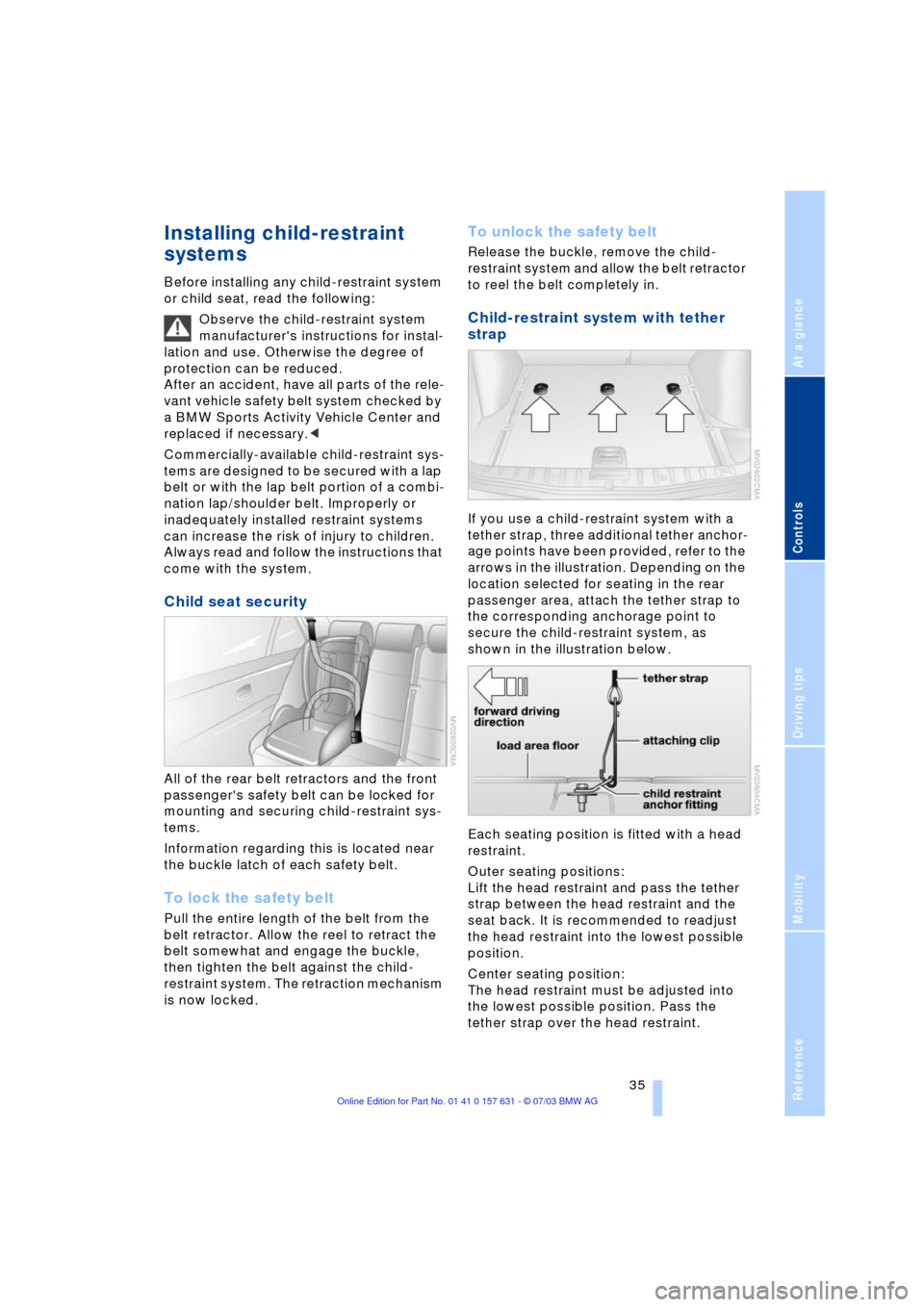
Reference
At a glance
Controls
Driving tips
Mobility
35
Installing child-restraint
systems
Before installing any child-restraint system
or child seat, read the following:
Observe the child-restraint system
manufacturer's instructions for instal-
lation and use. Otherwise the degree of
protection can be reduced.
After an accident, have all parts of the rele-
vant vehicle safety belt system checked by
a BMW Sports Activity Vehicle Center and
replaced if necessary.<
Commercially-available child-restraint sys-
tems are designed to be secured with a lap
belt or with the lap belt portion of a combi-
nation lap/shoulder belt. Improperly or
inadequately installed restraint systems
can increase the risk of injury to children.
Always read and follow the instructions that
come with the system.
Child seat security
All of the rear belt retractors and the front
passenger's safety belt can be locked for
mounting and securing child-restraint sys-
tems.
Information regarding this is located near
the buckle latch of each safety belt.
To lock the safety belt
Pull the entire length of the belt from the
belt retractor. Allow the reel to retract the
belt somewhat and engage the buckle,
then tighten the belt against the child-
restraint system. The retraction mechanism
is now locked.
To unlock the safety belt
Release the buckle, remove the child-
restraint system and allow the belt retractor
to reel the belt completely in.
Child-restraint system with tether
strap
If you use a child-restraint system with a
tether strap, three additional tether anchor-
age points have been provided, refer to the
arrows in the illustration. Depending on the
location selected for seating in the rear
passenger area, attach the tether strap to
the corresponding anchorage point to
secure the child-restraint system, as
shown in the illustration below.
Each seating position is fitted with a head
restraint.
Outer seating positions:
Lift the head restraint and pass the tether
strap between the head restraint and the
seat back. It is recommended to readjust
the head restraint into the lowest possible
position.
Center seating position:
The head restraint must be adjusted into
the lowest possible position. Pass the
tether strap over the head restraint.
Page 40 of 132
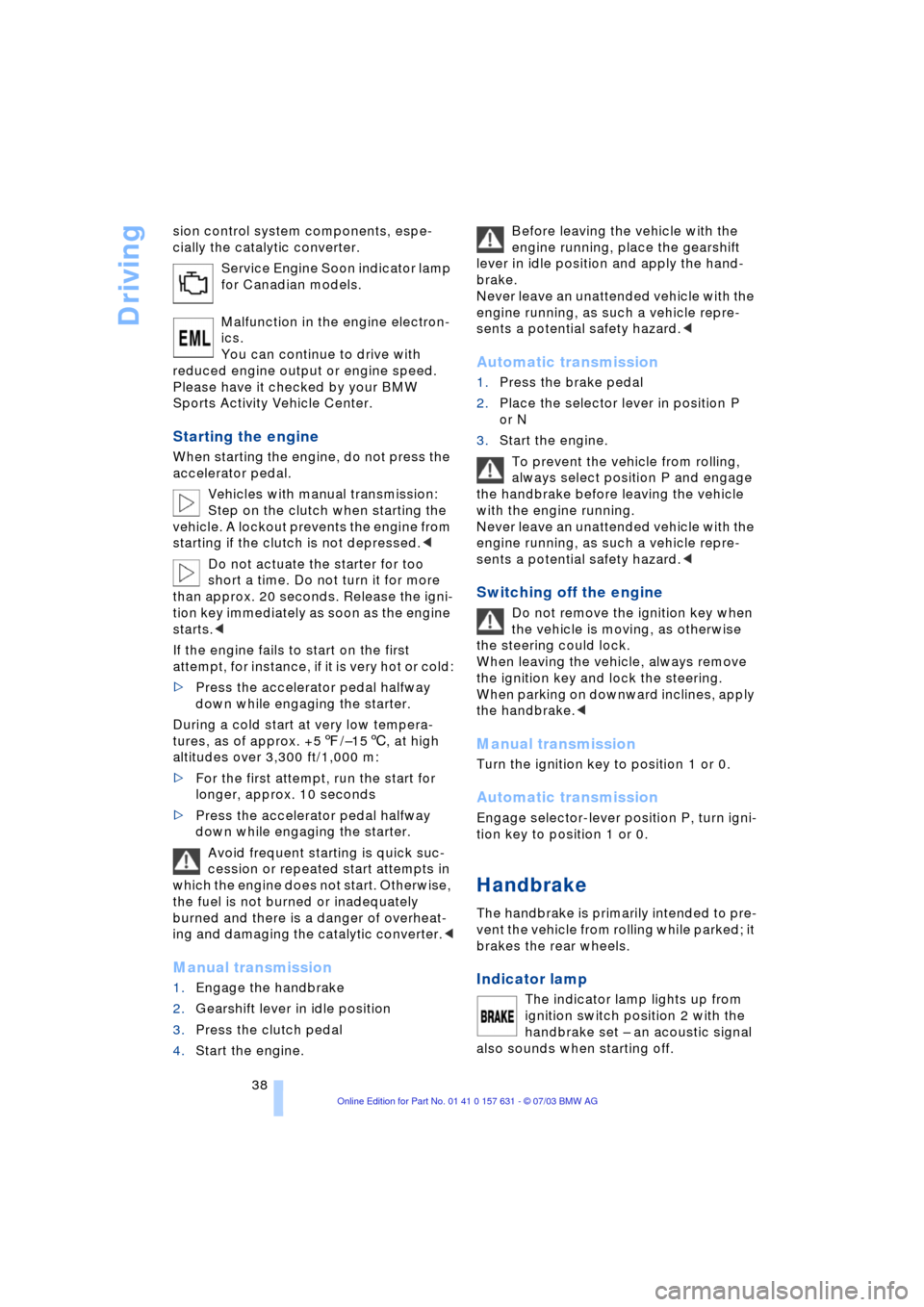
Driving
38 sion control system components, espe-
cially the catalytic converter.
Service Engine Soon indicator lamp
for Canadian models.
Malfunction in the engine electron-
ics.
You can continue to drive with
reduced engine output or engine speed.
Please have it checked by your BMW
Sports Activity Vehicle Center.
Starting the engine
When starting the engine, do not press the
accelerator pedal.
Vehicles with manual transmission:
Step on the clutch when starting the
vehicle. A lockout prevents the engine from
starting if the clutch is not depressed.<
Do not actuate the starter for too
short a time. Do not turn it for more
than approx. 20 seconds. Release the igni-
tion key immediately as soon as the engine
starts.<
If the engine fails to start on the first
attempt, for instance, if it is very hot or cold:
>Press the accelerator pedal halfway
down while engaging the starter.
During a cold start at very low tempera-
tures, as of approx. +57/Ð156, at high
altitudes over 3,300 ft/1,000 m:
>For the first attempt, run the start for
longer, approx. 10 seconds
>Press the accelerator pedal halfway
down while engaging the starter.
Avoid frequent starting is quick suc-
cession or repeated start attempts in
which the engine does not start. Otherwise,
the fuel is not burned or inadequately
burned and there is a danger of overheat-
ing and damaging the catalytic converter.<
Manual transmission
1.Engage the handbrake
2.Gearshift lever in idle position
3.Press the clutch pedal
4.Start the engine.Before leaving the vehicle with the
engine running, place the gearshift
lever in idle position and apply the hand-
brake.
Never leave an unattended vehicle with the
engine running, as such a vehicle repre-
sents a potential safety hazard.<
Automatic transmission
1.Press the brake pedal
2.Place the selector lever in position P
or N
3.Start the engine.
To prevent the vehicle from rolling,
always select position P and engage
the handbrake before leaving the vehicle
with the engine running.
Never leave an unattended vehicle with the
engine running, as such a vehicle repre-
sents a potential safety hazard.<
Switching off the engine
Do not remove the ignition key when
the vehicle is moving, as otherwise
the steering could lock.
When leaving the vehicle, always remove
the ignition key and lock the steering.
When parking on downward inclines, apply
the handbrake.<
Manual transmission
Turn the ignition key to position 1 or 0.
Automatic transmission
Engage selector-lever position P, turn igni-
tion key to position 1 or 0.
Handbrake
The handbrake is primarily intended to pre-
vent the vehicle from rolling while parked; it
brakes the rear wheels.
Indicator lamp
The indicator lamp lights up from
ignition switch position 2 with the
handbrake set Ð an acoustic signal
also sounds when starting off.
Page 46 of 132

Driving
44
Interrupting the cruise control
When the system is activated, press but-
ton. The indicator lamp stays on. You can
use the cruise control again whenever
required by calling up the speed that was
stored last.
In addition, the system is automatically
interrupted in response to the following
conditions:
>When you apply pressure to the brake
pedal
>When you apply pressure to the clutch
pedal or when you move the automatic
transmission selector lever from D to N
>If you exceed or fall below the con-
trolled speed for an extended period,
by pressing the accelerator, for exam-
ple.
Recalling the stored speed
Press button:
The vehicle accelerates to and maintains
the last speed stored.
Page 52 of 132
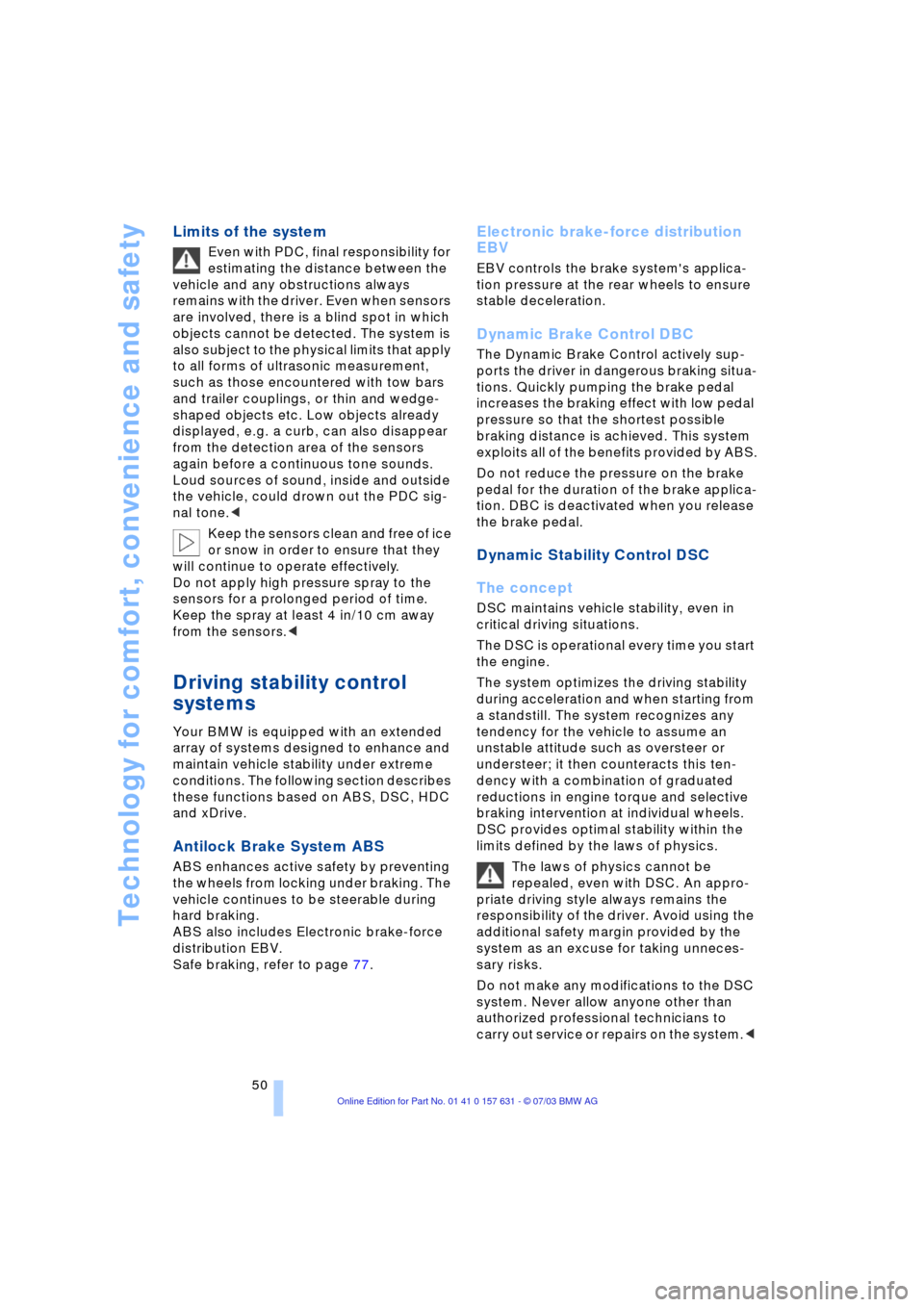
Technology for comfort, convenience and safety
50
Limits of the system
Even with PDC, final responsibility for
estimating the distance between the
vehicle and any obstructions always
remains with the driver. Even when sensors
are involved, there is a blind spot in which
objects cannot be detected. The system is
also subject to the physical limits that apply
to all forms of ultrasonic measurement,
such as those encountered with tow bars
and trailer couplings, or thin and wedge-
shaped objects etc. Low objects already
displayed, e.g. a curb, can also disappear
from the detection area of the sensors
again before a continuous tone sounds.
Loud sources of sound, inside and outside
the vehicle, could drown out the PDC sig-
nal tone.<
Keep the sensors clean and free of ice
or snow in order to ensure that they
will continue to operate effectively.
Do not apply high pressure spray to the
sensors for a prolonged period of time.
Keep the spray at least 4 in/10 cm away
from the sensors.<
Driving stability control
systems
Your BMW is equipped with an extended
array of systems designed to enhance and
maintain vehicle stability under extreme
conditions. The following section describes
these functions based on ABS, DSC, HDC
and xDrive.
Antilock Brake System ABS
ABS enhances active safety by preventing
the wheels from locking under braking. The
vehicle continues to be steerable during
hard braking.
ABS also includes Electronic brake-force
distribution EBV.
Safe braking, refer to page 77.
Electronic brake-force distribution
EBV
EBV controls the brake system's applica-
tion pressure at the rear wheels to ensure
stable deceleration.
Dynamic Brake Control DBC
The Dynamic Brake Control actively sup-
ports the driver in dangerous braking situa-
tions. Quickly pumping the brake pedal
increases the braking effect with low pedal
pressure so that the shortest possible
braking distance is achieved. This system
exploits all of the benefits provided by ABS.
Do not reduce the pressure on the brake
pedal for the duration of the brake applica-
tion. DBC is deactivated when you release
the brake pedal.
Dynamic Stability Control DSC
The concept
DSC maintains vehicle stability, even in
critical driving situations.
The DSC is operational every time you start
the engine.
The system optimizes the driving stability
during acceleration and when starting from
a standstill. The system recognizes any
tendency for the vehicle to assume an
unstable attitude such as oversteer or
understeer; it then counteracts this ten-
dency with a combination of graduated
reductions in engine torque and selective
braking intervention at individual wheels.
DSC provides optimal stability within the
limits defined by the laws of physics.
The laws of physics cannot be
repealed, even with DSC. An appro-
priate driving style always remains the
responsibility of the driver. Avoid using the
additional safety margin provided by the
system as an excuse for taking unneces-
sary risks.
Do not make any modifications to the DSC
system. Never allow anyone other than
authorized professional technicians to
carry out service or repairs on the system.<
Page 56 of 132
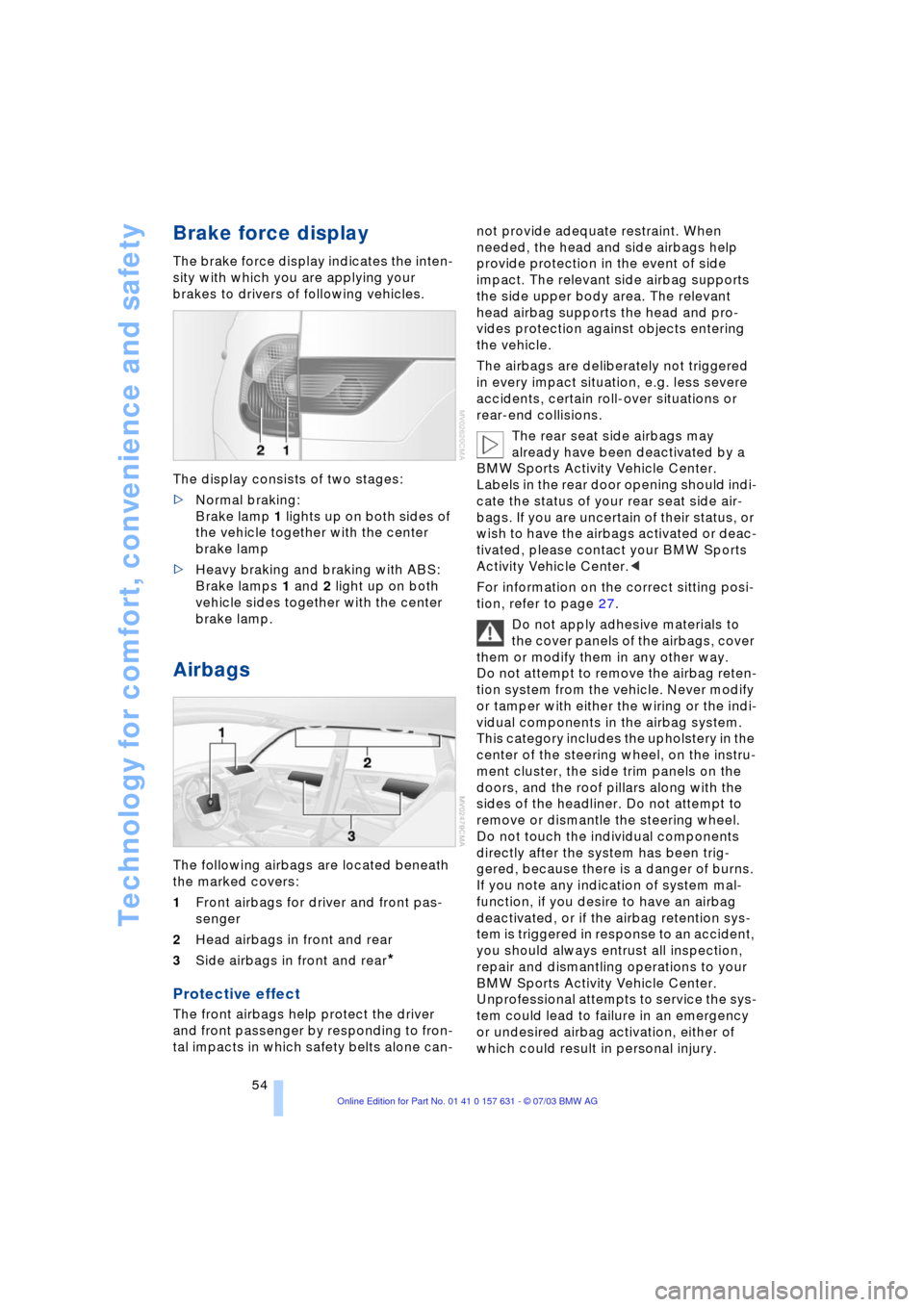
Technology for comfort, convenience and safety
54
Brake force display
The brake force display indicates the inten-
sity with which you are applying your
brakes to drivers of following vehicles.
The display consists of two stages:
>Normal braking:
Brake lamp 1 lights up on both sides of
the vehicle together with the center
brake lamp
>Heavy braking and braking with ABS:
Brake lamps 1 and 2 light up on both
vehicle sides together with the center
brake lamp.
Airbags
The following airbags are located beneath
the marked covers:
1Front airbags for driver and front pas-
senger
2Head airbags in front and rear
3Side airbags in front and rear
*
Protective effect
The front airbags help protect the driver
and front passenger by responding to fron-
tal impacts in which safety belts alone can-not provide adequate restraint. When
needed, the head and side airbags help
provide protection in the event of side
impact. The relevant side airbag supports
the side upper body area. The relevant
head airbag supports the head and pro-
vides protection against objects entering
the vehicle.
The airbags are deliberately not triggered
in every impact situation, e.g. less severe
accidents, certain roll-over situations or
rear-end collisions.
The rear seat side airbags may
already have been deactivated by a
BMW Sports Activity Vehicle Center.
Labels in the rear door opening should indi-
cate the status of your rear seat side air-
bags. If you are uncertain of their status, or
wish to have the airbags activated or deac-
tivated, please contact your BMW Sports
Activity Vehicle Center.<
For information on the correct sitting posi-
tion, refer to page 27.
Do not apply adhesive materials to
the cover panels of the airbags, cover
them or modify them in any other way.
Do not attempt to remove the airbag reten-
tion system from the vehicle. Never modify
or tamper with either the wiring or the indi-
vidual components in the airbag system.
This category includes the upholstery in the
center of the steering wheel, on the instru-
ment cluster, the side trim panels on the
doors, and the roof pillars along with the
sides of the headliner. Do not attempt to
remove or dismantle the steering wheel.
Do not touch the individual components
directly after the system has been trig-
gered, because there is a danger of burns.
If you note any indication of system mal-
function, if you desire to have an airbag
deactivated, or if the airbag retention sys-
tem is triggered in response to an accident,
you should always entrust all inspection,
repair and dismantling operations to your
BMW Sports Activity Vehicle Center.
Unprofessional attempts to service the sys-
tem could lead to failure in an emergency
or undesired airbag activation, either of
which could result in personal injury.
Page 57 of 132
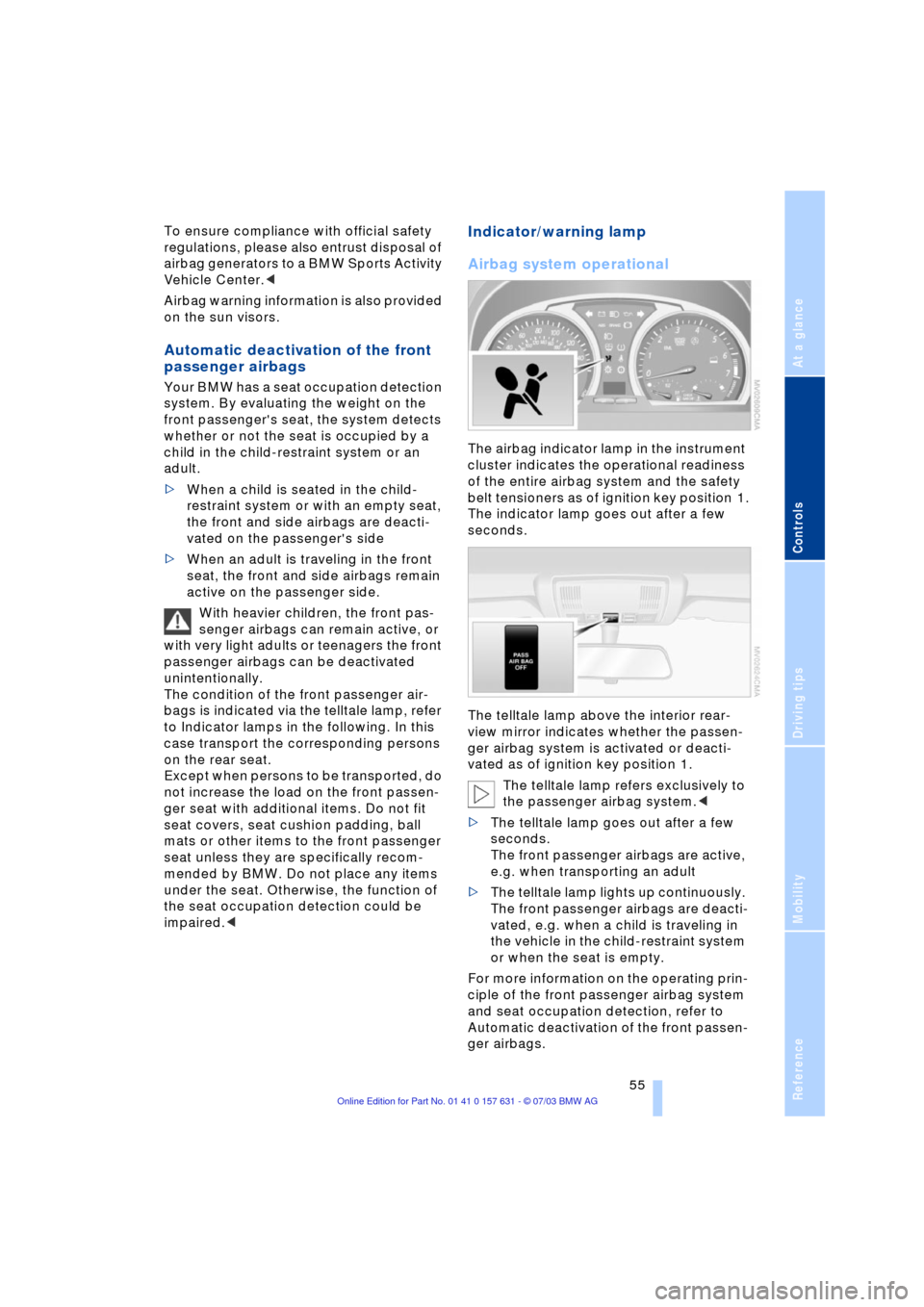
Reference
At a glance
Controls
Driving tips
Mobility
55
To ensure compliance with official safety
regulations, please also entrust disposal of
airbag generators to a BMW Sports Activity
Vehicle Center.<
Airbag warning information is also provided
on the sun visors.
Automatic deactivation of the front
passenger airbags
Your BMW has a seat occupation detection
system. By evaluating the weight on the
front passenger's seat, the system detects
whether or not the seat is occupied by a
child in the child-restraint system or an
adult.
>When a child is seated in the child-
restraint system or with an empty seat,
the front and side airbags are deacti-
vated on the passenger's side
>When an adult is traveling in the front
seat, the front and side airbags remain
active on the passenger side.
With heavier children, the front pas-
senger airbags can remain active, or
with very light adults or teenagers the front
passenger airbags can be deactivated
unintentionally.
The condition of the front passenger air-
bags is indicated via the telltale lamp, refer
to Indicator lamps in the following. In this
case transport the corresponding persons
on the rear seat.
Except when persons to be transported, do
not increase the load on the front passen-
ger seat with additional items. Do not fit
seat covers, seat cushion padding, ball
mats or other items to the front passenger
seat unless they are specifically recom-
mended by BMW. Do not place any items
under the seat. Otherwise, the function of
the seat occupation detection could be
impaired.<
Indicator/warning lamp
Airbag system operational
The airbag indicator lamp in the instrument
cluster indicates the operational readiness
of the entire airbag system and the safety
belt tensioners as of ignition key position 1.
The indicator lamp goes out after a few
seconds.
The telltale lamp above the interior rear-
view mirror indicates whether the passen-
ger airbag system is activated or deacti-
vated as of ignition key position 1.
The telltale lamp refers exclusively to
the passenger airbag system.<
>The telltale lamp goes out after a few
seconds.
The front passenger airbags are active,
e.g. when transporting an adult
>The telltale lamp lights up continuously.
The front passenger airbags are deacti-
vated, e.g. when a child is traveling in
the vehicle in the child-restraint system
or when the seat is empty.
For more information on the operating prin-
ciple of the front passenger airbag system
and seat occupation detection, refer to
Automatic deactivation of the front passen-
ger airbags.
Page 58 of 132

Technology for comfort, convenience and safety
56
Airbag system malfunction
A system malfunction could prevent
the system from responding in the
expected manner to an impact occurring
within its normal response range.
Please have the airbag system checked
immediately by a BMW Sports Activity
Vehicle Center.<
There is a fault in the airbag system
if the airbag indicator lamp in the
instrument cluster behaves as fol-
lows:
>Indicator lamp does not light up as of
ignition key position 1
>Indicator lamp remains lit continuously
>Indicator lamp lights up while the vehi-
cle is being driven.
Page 59 of 132
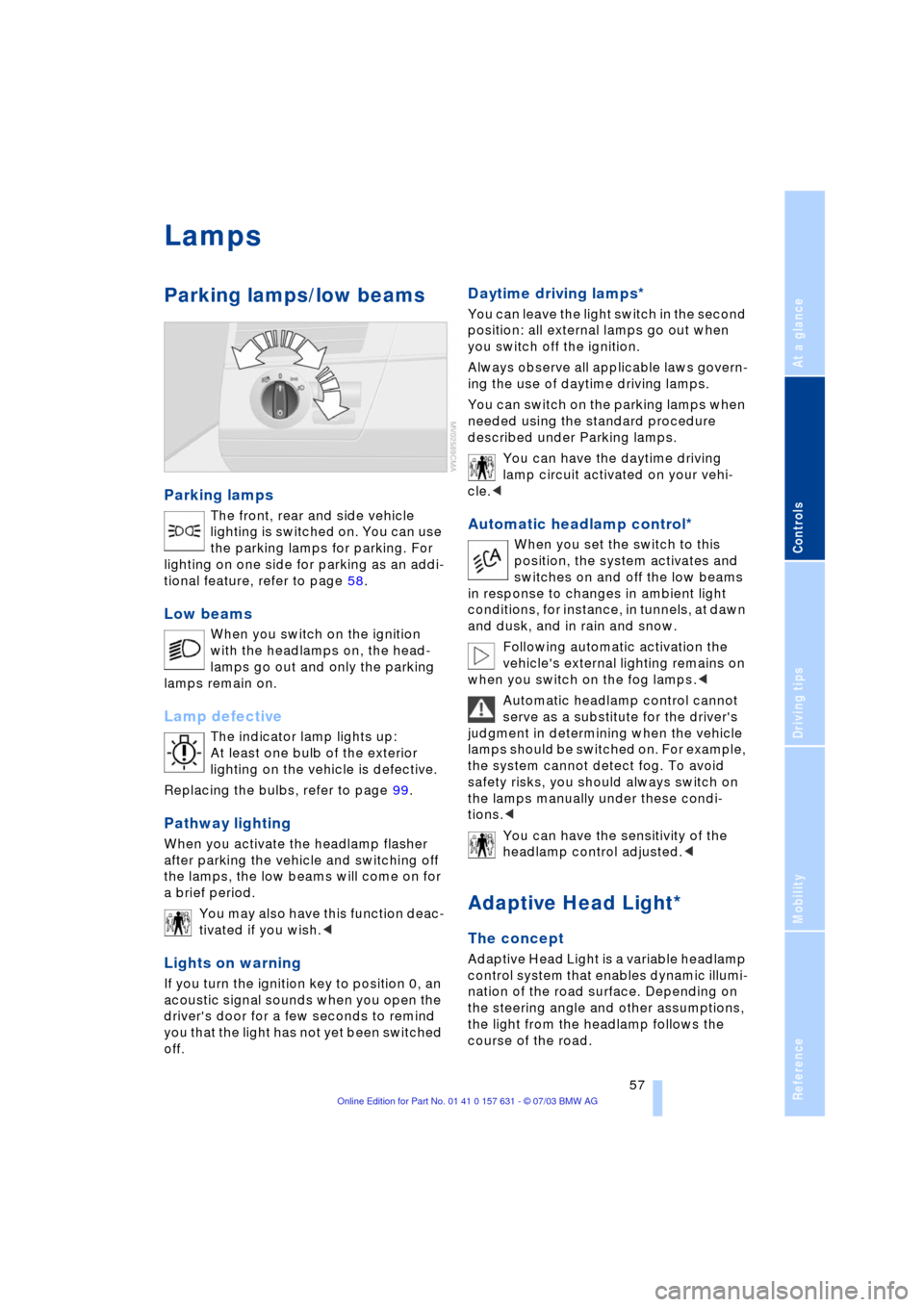
Reference
At a glance
Controls
Driving tips
Mobility
57
Lamps
Parking lamps/low beams
Parking lamps
The front, rear and side vehicle
lighting is switched on. You can use
the parking lamps for parking. For
lighting on one side for parking as an addi-
tional feature, refer to page 58.
Low beams
When you switch on the ignition
with the headlamps on, the head-
lamps go out and only the parking
lamps remain on.
Lamp defective
The indicator lamp lights up:
At least one bulb of the exterior
lighting on the vehicle is defective.
Replacing the bulbs, refer to page 99.
Pathway lighting
When you activate the headlamp flasher
after parking the vehicle and switching off
the lamps, the low beams will come on for
a brief period.
You may also have this function deac-
tivated if you wish.<
Lights on warning
If you turn the ignition key to position 0, an
acoustic signal sounds when you open the
driver's door for a few seconds to remind
you that the light has not yet been switched
off
.
Daytime driving lamps*
You can leave the light switch in the second
position: all external lamps go out when
you switch off the ignition.
Always observe all applicable laws govern-
ing the use of daytime driving lamps.
You can switch on the parking lamps when
needed using the standard procedure
described under Parking lamps.
You can have the daytime driving
lamp circuit activated on your vehi-
cle.<
Automatic headlamp control*
When you set the switch to this
position, the system activates and
switches on and off the low beams
in response to changes in ambient light
conditions, for instance, in tunnels, at dawn
and dusk, and in rain and snow.
Following automatic activation the
vehicle's external lighting remains on
when you switch on the fog lamps.<
Automatic headlamp control cannot
serve as a substitute for the driver's
judgment in determining when the vehicle
lamps should be switched on. For example,
the system cannot detect fog. To avoid
safety risks, you should always switch on
the lamps manually under these condi-
tions.<
You can have the sensitivity of the
headlamp control adjusted.<
Adaptive Head Light*
The concept
Adaptive Head Light is a variable headlamp
control system that enables dynamic illumi-
nation of the road surface. Depending on
the steering angle and other assumptions,
the light from the headlamp follows the
course of the road.
Page 63 of 132

Reference
At a glance
Controls
Driving tips
Mobility
61
Air supply/blower
You can select blower speeds 1
to 4. The heating and ventilation
become more and more effec-
tive as the air supply settings
are increased. In position 0, the
blower and heater are switched off. The air
supply is blocked in position 0.
Temperature
To increase the temperature of
the interior, turn to the right.
Air distribution
You can direct air to flow onto
the windows , toward the
upper body and into the
footwell . All intermediate
settings are possible. In the
setting, there is a low flow of air onto the
windows to keep them free of condensa-
tion.
Rear window defroster
When the rear window
defroster is activated,
the indicator lamp comes on.
The rear window defroster switches off
automatically.
You can have your vehicle pro-
grammed in such a way that the rear
window defroster switches on automati-
cally. It is then switched on at outside tem-
peratures of less than approx. +46/397
within 5 minutes of the engine start.<
Air conditioning
The air is cooled and dehumidi-
fied and Ñ depending on the
temperature setting Ñ warmed
again. Depending on the weather, the
windshield may fog over briefly when the
engine is started. You can reduce conden-
sation forming on the windows by switch-
ing on the air conditioning.
During air conditioning condensation
forms, which then exits under the vehicle. Traces of condensed water of this
kind are thus normal.<
Outside air/recirculated-air mode
You can respond to unpleasant
odors outside the vehicle by
temporarily switching off the
outside air supply. The system then recir-
culates the air currently within the vehicle.
If condensation starts to form on the
inside window surfaces during opera-
tion in the recirculated-air mode, you
should switch it off while also increasing air
supply as required. The recirculated-air
mode should not be used over a sustained
longer period of time, as the air quality
inside the vehicle deteriorates.<
Ventilation
The air vents for the upper body area can
be adjusted:
1Serrated dials 1 for steplessly opening
and closing the air vents
2Selector levers for airflow direction
3Use the serrated dial 3 to adjust the
amount of cool air that is added to the
airflow emerging from the vent outlets
for the upper body
Ventilation for cooling
Adjust the vents to direct the flow of cool
air in your direction, for instance, if the inte-
rior has become too warm, etc.
Draft-free ventilation
Set the vent outlets so that the air flows
past you and is not directed straight at you.
Page 66 of 132

A congenial climate
64
A congenial climate
Use the automatic facility by operating the
AUTO button 12. Select an interior tem-
perature that is comfortable for you.
Detailed setting options are described for
you in the following section.
Your vehicle has been designed to
automatically select your personal cli-
mate-control settings whenever you unlock
the doors using your individually pro-
grammed remote control.<
If you want, you can have this function
deactivated.<
Automatic air distribution and supply
The AUTO program adjusts the
airflow and distribution patterns
for you while also using your
preselected temperature setting as the
basis for adjusting the interior climate to
adapt to external influences Ð summer, win-
ter.
Individual air distribution
You can cancel the AUTO pro-
gram by selecting specific air
distribution patterns for your
personal comfort, the auto-
matic air supply remains in
operation. You can direct air to
flow onto the windows , toward the
upper body , and into the footwell .
You can reactivate the automatic air distri-
bution mode by selecting the AUTO button.
Temperature
The figures in the display pro-
vide a general indication of inte-
rior temperature. When you
start the vehicle, this system
ensures that the selected tem-
perature is achieved as quickly
as possible. It then maintains this tempera-
ture, regardless of the season.
Air supply/blower
You can vary the air supply by
pressing the upper or lower
button. This switches off the
automatic program for the air
supply, and the word AUTO
goes out in the display. The automatic
mode for air distribution remains in opera-
tion as before. You can reactivate the auto-
matic air supply mode by selecting the
AUTO button.
If you press the lower button when at the
lowest blower speed, all displays go out:
the blower, heating and air conditioner are
switched off. The outside air supply is
closed. You can restart the automatic cli-
mate control by pressing any of its buttons.
Defrosting windows and removing
condensation
This program quickly removes
ice and condensation from the
windshield and door windows.
Air conditioner
The air is cooled and dehumid-
ified and Ñ depending on the
temperature setting Ñ warmed
again. Depending on the weather, the
windshield may fog over briefly when the
engine is started. The window mist is
reduced during A/C operation.
The air conditioner comes on automatically
when you select the AUTO program.
During air conditioning condensation
forms, which then exits under the
vehicle. Traces of condensed water of this
kind are thus normal.<
Outside air/AUC Automatic
recirculated-air control/
Recirculated-air mode
You can respond to unpleasant
odors or pollutants in the imme-
diate environment by tempo-
rarily suspending the supply of outside air.
The system then recirculates the air cur-
rently within the vehicle. Press the button